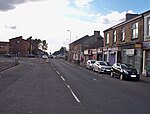Mossend International Railfreight Park
BellshillRail transport in ScotlandRail yards in the United KingdomTransport in North Lanarkshire
Mossend International Railfreight Park (previously known as Mossend Railhead) is a freight-handling station in Mossend, Scotland. It is situated across the line from the Mossend EuroTerminal.
Excerpt from the Wikipedia article Mossend International Railfreight Park (License: CC BY-SA 3.0, Authors).Mossend International Railfreight Park
Barochan Road,
Geographical coordinates (GPS) Address Nearby Places Show on map
Geographical coordinates (GPS)
| Latitude | Longitude |
|---|---|
| N 55.8243 ° | E -3.999 ° |
Address
Barochan Road
Barochan Road
ML4 1EJ , Wester Holytown
Scotland, United Kingdom
Open on Google Maps








